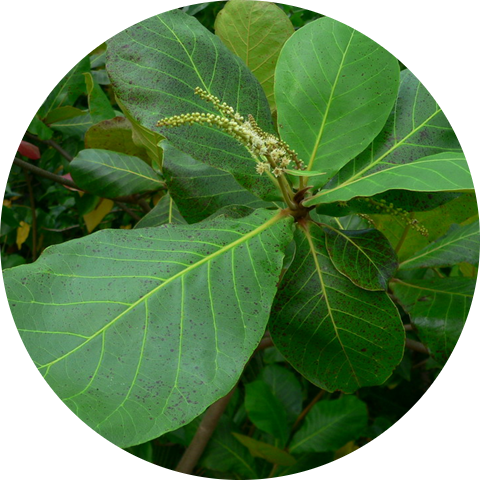- PLANT MEDICINE
- >
- Tinctures
- >
- TROPICAL ALMOND LEAF TINCTURE
TROPICAL ALMOND LEAF TINCTURE
Family: Combretaceae
Genus: Terminalia
Species: catappa
Synonyms: Terminalia moluccana, Juglans catappa, Myrobalanus catappa
Common Names: Tropical almond, Indian almond, Sea almond
Parts Used: Leaves, bark, fruits, seeds
Main Actions: Antioxidant, anti-inflammatory, antimicrobial, astringent
Other Actions: Antidiabetic, hepatoprotective, wound healing
Description: Tropical almond is a large deciduous tree with broad, glossy leaves and edible fruits. It is native to tropical regions and commonly found near coastlines.
Tribal and Herbal Medicine Uses: Used in traditional medicine for treating diarrhea, dysentery, wounds, skin disorders, and diabetes.
Plant Chemicals: Tannins, flavonoids, saponins, phenolic compounds, alkaloids
Biological Activities and Clinical Research: Demonstrated antioxidant, antimicrobial, and wound healing properties in various studies.
Current Practical Uses: Leaves are used in aquariums to lower pH and provide medicinal benefits for fish.
Main Preparation Method: Infusion or decoction of leaves, bark, or fruits.
Main Actions (in order): Antibacterial, Antifungal, Antioxidant, Anti-inflammatory, Antimicrobial, Antiparasitic, Astringent
Main Uses: Used to treat diarrhea, dysentery, wounds, skin disorders, and diabetes.
Properties/Actions Documented by Research: Antioxidant, antimicrobial, wound healing
Other Properties/Actions Documented by Traditional Use: Antidiabetic, hepatoprotective
Cautions: No serious adverse effects reported, but excessive use may cause constipation.
Traditional Preparation: Leaves are brewed into a tea or applied topically as a poultice.
Contraindications: None known
Drug Interactions: No significant interactions reported.
Recommended dosage: 1 - 2ml taken 2x daily in a small glass of water or juice on an empty stomach for better absorption.



